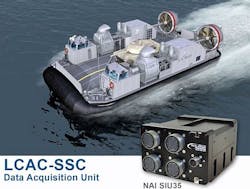North Atlantic Industries to provide data-control embedded computer on Navy's next-generation landing craft
Designers at L-3 Maritime Systems in Newburyport, Mass., have selected NAI to provide the company's SIU35 sensor interface unit embedded computer for the Navy's Ship to Shore Connector (SSC) program, which will replace the current Navy fleet of ageing Landing Craft Air Cushion (LCAC) vessels.
The NAI SIU35 sensor interface unit is an advanced, rugged, and intelligent I/O and communications subsystem for data acquisition and control that provides modularity and distributed interfaces over Ethernet using commercial-off-the-shelf (COTS) products.
L-3 Maritime Systems is a subcontractor to the Textron Inc. Marine & Land Systems segment in New Orleans, which is designing the SSC vessel. Sponsoring the SSC program is the Naval Sea Systems Command in Washington.
Related: Navy authorizes Textron to start building one of first LCAC replacement vessels
The NAI SIU35 will be part of the SSC's data-acquisition unit, and will enable population of each board with function-specific modules. The SIU35 enables systems designers to select as many as 15 different functions from an assortment of low-power, high-density modules, NAI officials say.
Functions include programmable discrete analog I/O (A/D, D/A and RTD), communications (RS-232/422/485 and ARINC-429), LVDT measurement, RVDT simulation, and LVDT/RVDT AC excitation.
Not only does the SIU35 represent an important design-in win for NAI, but it also is among the company's initial contracts for the NAI Custom-on-Standard Architecture (COSA), company officials say.
story continues below
COSA-enabled designs incorporate a mix of processors and field-programmable gate arrays (FPGAs) that perform motion control, process control, monitoring, data transfer, and background built-in-test (BIT). The NAI COSA design approach is designed to provide an adaptive programmable architecture with intelligence and functionality in a small footprint and at a low cost, company officials say.
The space, weight, power, and cost (SWaP-C)-optimized design of the SIU35 increases packaging density, saves enclosure slots, and reduces power consumption, resulting in easy integration, cost savings and no non-recurring engineering (NRE), NAI officials say.
The SIU35 also incorporates automatic background built-in-test (BIT) testing that is always enabled and continually checks the health of each channel.
"By employing NAI's scalable COSA architecture, L-3 Maritime Systems was able to choose a platform prior to completion of a detailed design," says Tim Lorenzen, senior engineering manager at L-3 Maritime Systems. "As the craft's systems interface designs changed, we were able to accommodate that functionality simply by changing I/O modules on the NAI multifunction I/O boards. This allowed us to move forward with development and hardware decisions earlier, keeping the program on schedule."
"The SSC program is another example of how our modular and adaptive COSA delivers efficient SWaP-C I/O-intensive boards and systems in less time at a lower system cost," says Lino Massafra, vice president of sales and marketing for NAI.
"Our ability to mix and match functions gives customers a solution without the high costs typically associated with other vendors' custom box designs," Massafra says. "We were able to quickly provide L-3 Maritime Systems with distributed I/O solutions that met its demanding requirements, all with no NRE."
For more information contact North Atlantic Industries online at www.naii.com, L-3 Maritime Systems at www.l-3mps.com/maritimesystems, Textron Systems at www.textronsystems.com, or Naval Sea Systems Command at www.navsea.navy.mil.
